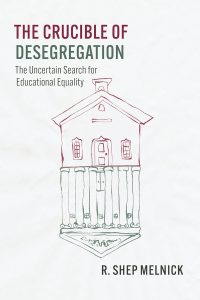 In The Crucible of Desegregation: The Uncertain Search for Educational Equality, R. Shep Melnick examines the evolution of federal school desegregation policy in the US from 1954 through the termination of desegregation orders in the first decades of the 21st century. Combining legal analysis with a focus on institutional relations, Melnick’s analysis of the difficulty of defining and implementing desegregation is a valuable contribution to the fields of law, history and educational studies, writes Pabitra Saha.
In The Crucible of Desegregation: The Uncertain Search for Educational Equality, R. Shep Melnick examines the evolution of federal school desegregation policy in the US from 1954 through the termination of desegregation orders in the first decades of the 21st century. Combining legal analysis with a focus on institutional relations, Melnick’s analysis of the difficulty of defining and implementing desegregation is a valuable contribution to the fields of law, history and educational studies, writes Pabitra Saha.
The Crucible of Desegregation: The Uncertain Search for Educational Equality. R. Shep Melnick, The University of Chicago Press. 2023.
 R. Shep Melnick’s The Crucible of Desegregation examines desegregation policies in the US since the 1950s. The freedom to attend a desegregated school was declared a national constitutional right by the Supreme Court in Brown v. Board of Education in 1954, yet the ruling was rife with major contradictions. The Supreme Court has never provided a precise definition of desegregation or established a methodology for weighing conflicting views. Combining legal analysis with a focus on institutional relations, particularly the interactions between federal judges and administrators, Melnick examines the inconsistent development of federal school desegregation policies through the termination of desegregation orders.
R. Shep Melnick’s The Crucible of Desegregation examines desegregation policies in the US since the 1950s. The freedom to attend a desegregated school was declared a national constitutional right by the Supreme Court in Brown v. Board of Education in 1954, yet the ruling was rife with major contradictions. The Supreme Court has never provided a precise definition of desegregation or established a methodology for weighing conflicting views. Combining legal analysis with a focus on institutional relations, particularly the interactions between federal judges and administrators, Melnick examines the inconsistent development of federal school desegregation policies through the termination of desegregation orders.
The freedom to attend a desegregated school was declared a national constitutional right by the Supreme Court in Brown v. Board of Education in 1954, yet the ruling was rife with major contradictions.
The book begins by providing a thorough policy history of desegregation, from Brown to the revocation of several court decrees in the early 21st century. Melnick’s legal analysis pays particular attention to the symbolic bond that early courts and agencies formed, the Supreme Court’s nine justices’ inability to give the lower courts clear guidance, the use of creative judicial remedies, and the varied ways that lower courts responded to the complex problems they faced. The author notes that in the past 50 years, immigration, globalisation, and technological advancement have made education significantly more crucial for achieving financial success.
Melnick’s legal analysis pays particular attention to the symbolic bond that early courts and agencies formed, the Supreme Court’s nine justices’ inability to give the lower courts clear guidance, the use of creative judicial remedies, and the varied ways that lower courts responded to the complex problems they faced.
The vagueness of the declared purpose of “desegregation”, as well as the near-universal dogmatic insistence that the only meaning of that term was the one consistent with the constitution (Brown), and the objective of racial justice hang over the whole six-decade saga. Chapter 1, “Why Desegregation Still Matters” raises the question, “to what extent will the federal judiciary, stocked with many additional Republican appointees, build upon or limit the efforts by the executive branch?” (21). Melnick argues that the legacy of the desegregation effort extends far beyond race and schooling.
Chapter 2, “The Great Debate,” examines several perspectives on desegregation along with data demonstrating the results of desegregation initiatives. It describes the “color-blind/limited intervention” perspective, and the “racial isolation/equal educational opportunity” position which the author terms the two most dominant viewpoints. Both strategies offer substantial advantages and disadvantages, and because of this, few judges have been ready to fully adopt either. The author’s examination of how interpretations of desegregation are inconclusive and variable explains why desegregation, the unitary (integrated) school system, and resegregation are worlds apart from the educational practices that affect the lives of teachers and students.
Chapter 3, “Critical Juncture” highlights some of the major events in the history of the federal de-segregation effort. These include the Civil Rights Act of 1964, which brought two federal departments to the aid of civil rights litigants, the Fifth Circuit’s Jefferson County decisions from 1966 to 1967, which sped up desegregation in the South, and the Supreme Court’s flurry of desegregation decisions. The tortuous evolution of federal desegregation policy in the executive branch, courts, and to a lesser extent, Congress provided the desegregation of Southern schools and shifted the focus to Congress and the executive.
Chapter 4, “Breakthrough: “The Reconstruction of Southern Education,” examines how, in the second half of the 1960s, the Fifth Circuit collaborated with the Office of Civil Rights to overcome Southern opposition to desegregation. It took tremendous institutional innovation to accomplish this. The “Supreme Court [made] it clear that school boards cannot avoid their responsibility to create a unitary system simply by resorting to nondiscriminatory, geographical zoning where such zoning would be ineffective” (105). The Supreme Court delivered 25 desegregation rulings during those years, more than twice as many as it had previously or after more than a decade of dodging the topic. The Court’s view on “racial isolation/equal educational opportunity” became more ambivalent as a result of the combination of these rulings. But the judges never explained this change. Chapter 5, “Supreme Abdication,” contends that the major cause of the failure has been the inability of the justices to agree on the underlying nature of the enterprise (143).
The way the structural injunction developed reflected the significant federal authority exerted both to reform education in metropolitan areas across the nation and to reconstruct education in the South. To enable educational equality, the judges need to pay attention to what happens inside schools in terms of tracking, discipline, professional training, curriculum, bilingual education, special education, guidance, and counselling programmes, which are elements of judicial security.
The ad-hoc character of the desegregation process and the decentralisation of judicial policymaking had to cater to the different varieties of desegregation, and the experiences of these, which were changing over time.
The ad-hoc character of the desegregation process and the decentralisation of judicial policymaking had to cater to the different varieties of desegregation, and the experiences of these, which were changing over time. The “unitary school system” and the many variations between judges and localities are discussed in Chapter 7’s section on “Varieties of Desegregation Experiences.” It is difficult to summarise how court-ordered integration initiatives transpired nationwide, and the court judgment depends on how “desegregation” is understood. So, Melnick pieces together the Supreme Court’s ruling on the appropriate time for school districts to be awarded “unitary status,” the reactions of subordinate courts to the rulings, how court rulings have encouraged resegregation, and how the revocation of court orders has impacted minority students’ academic performance.
As Melnick contends, ‘educational reform calls for consistent work, clarity about goals, appreciation of modest improvements, awareness of unintended effects, and frequent evaluation of results.’
Chapter 9, “Looking Beyond Courts” contends that, despite their prominence, judges have not been the only federal authorities tasked with ensuring educational equality of opportunity. The first section of the chapter looks at legislative initiatives to use funding and requirements to enhance education for underprivileged and underrepresented children, English-language learners, women and girls, and students with disabilities. The problems of school desegregation included resource inequalities, specialised programmes for English learners, criteria for assigning students to special education, discrimination in tracking and discipline, and racial harassment, which were the most controversial education issues addressed by the federal government. As Melnick contends, “educational reform calls for consistent work, clarity about goals, appreciation of modest improvements, awareness of unintended effects, and frequent evaluation of results.” There are several veto points in the legislative process because of the separation of powers, bicameralism, and decentralisation within both chambers of Congress. So, the changing scenario of the education system with the federal role expanded due to political institutions’ efforts.
Equality and justice are the crucial aspects of the desegregation of school education, but the task of bearing out these principles across the federal US in the past seven decades has been enormously complicated as the author argues.
Melnick observes that, “[i]n recent decades, the well-educated have become richer and the poorly educated poorer, making the quality of public education more important than ever before” (249). Equality and justice are the crucial aspects of the desegregation of school education, but the task of bearing out these principles across the federal US in the past seven decades has been enormously complicated as the author argues, a greater emphasis is now being placed on raising the standard of instruction in urban school systems rather than on preserving racial balance.
The progress of American civil rights generally largely developed from school desegregation.
Critically, the progress of American civil rights generally largely developed from school desegregation. As Melnick states, “Equal and racially integrated schools are good for students and good for democracy in any educational setting.” The Crucible of Desegregation offers a patchwork view of desegregation policy, revealing how administrators and judges in lower courts played a pivotal role, with remarkable achievements and setbacks alike. The book is a valuable and pragmatic resource for those interested in learning more about this history of desegregation and the court system in the US. Its focus on equality and justice reflects a world in which initiatives like the UN Sustainable Development Goals aim to drive greater equality and justice for disadvantaged groups.
- This review first appeared at LSE Review of Books.
- Image Credit: Nina Alizada on Shutterstock.
- Please read our comments policy before commenting.
- Note: This article gives the views of the reviewer, and not the position of USAPP – American Politics and Policy, nor of the London School of Economics.
- Shortened URL for this post: https://bit.ly/411QtN8






